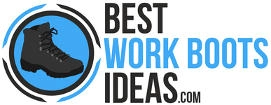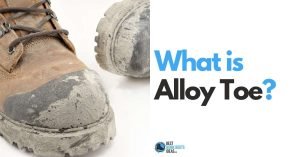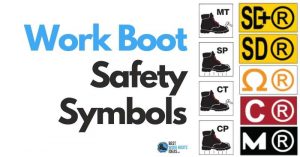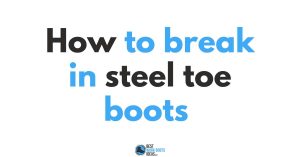Are Logger Boots Bad For Your Back? Learn Everything You Need to Know About How to Balance Protection and Comfort
![Are Logger Boots Bad for your Back? [featured image]](https://www.bestworkbootsideas.com/wp-content/uploads/2022/01/are-logger-boots-bad-for-your-back-featured-image.jpg)
The short answer is that it depends on where you’re working. If you’re in the logging industry on hills and mountains, you’ll want a pair of loggers. If you’re in general construction, spending most of your day on relatively level ground, yes, logger boots can be bad for your back.
There are reasons why this boot style can be good for one type of work while bad for another.
Today I’ll go into all the reasons you would or wouldn’t want a pair of logger boots.
Contents
Are Logger Boots Different Than Work Boots?
Yes, there are a handful of distinct differences between logger boots and general work boots. Logger boots go further up the leg, have higher heels, and often have a kiltie at the base of the tongue. In contrast, work boots are shorter in throat and heel height and are often more flexible.
Another difference that results from all the aspects I mentioned above is the boot’s overall weight. While both loggers and work boots can come with similar safety features, the fact that there is simply more boot with loggers results in a heavier boot overall.
More leather exteriors, more heel, more padding, more eyelets and laces, and often metatarsal protection. I’ve written articles on the comparison between logger boots and work boots, something that’s a good idea to check out if you want to thoroughly understand this topic.
I’ve also written a complete breakdown of the features found in logger boots. Again, this is something that will be helpful to read if you’re truly interested in this topic.
Why Are Logger Boots Bad For Your Back?
Logger boots can be bad for your back because of the extra high heel and the excess weight you’ll be carrying around while wearing them. When used on flat terrain, the combination of these two features can put unnecessary stress on your legs and back.
When used on flat floors or relatively level earth, the extra tall heel will push your whole body forward. In a very real way, it’s like you’re leaning forward at all times, ever so slightly.
This probably isn’t something you would notice if you put the boots on for an hour or even a couple of days, but your body would absolutely notice.
As we shift our stance and gait, either by conscious choice or due to the equipment we’re wearing, our body instinctively compensates.
This subconscious compensation our body is doing reflexively results in each bone, muscle, and tendon performing a task it was never designed to do.
Little changes over a long period of time can result in unexplained pain in unexplained places. It’s important to consider the human body as a completely interconnected system.
This isn’t speculation or conjecture. Go check out one of the scientific studies on this topic.
There’s also the weight aspect, which is more straightforward and easily understood. If you’re putting greater physical demand on your body with each step, it’s only natural that it will tire and experience pain.
I recently wrote an article on the weight of steel toe boots that gets into this topic in greater depth.
Even though the subject matter is slightly different, there’s a good amount of overlap that will allow you to further understand the subject.
With the article I just linked to, coupled with common sense, the second point needs no further explanation.
Anyone who’s lived a couple of years knows the difference between carrying something light or heavy.
Whether at the gym or with the ASTM f2413 PPE equipment we wear to stay safe at work, more weight is more stress; it’s that simple.
Over time, this added weight makes a huge difference with stress and overall fatigue.
When Are Logger Boots Good For Your Back?
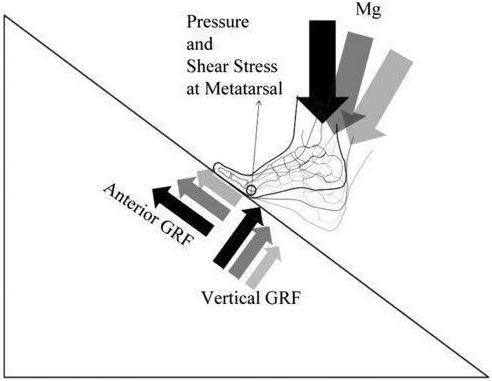
Source: The Effect of Backpack Load Carriage on the Kinetics and Kinematics of Ankle and Knee Joints During Uphill Walking- in Journal of Applied Biomechanics
Logger boots are a great idea any time you can expect to be spending a lot of your work trekking uphill.
The raised heel of a logger boot offsets the stress on your foot, leg, and back by limiting the distance between your foot and the ground beneath it.
The reason for the tall heel of logger boots might not be immediately apparent to you, so allow me to explain.
The image above depicts this situation with a naked foot (not wearing footwear) and is helpful to understand what I’m talking about.
Imagine you’re walking up a relatively steep incline, as you would if you were working a logging operation on a forested mountainside.
In that situation, the ball of the foot will hit the ground far before the heel, while the heel has far further to drop.
This situation puts stress on the metatarsal bones, the Achilles tendon, and continues going up the hamstrings and back.
Not a single part of the human body works independently of the things it’s connected to, so that’s how extra stress in your lower legs can reach the back.
The raised heel of logger boots compensates for this extra drop caused by the slope of the walking surface.
Simply put, if you’re on uneven terrain, the heel tricks your feet and body into thinking that it’s walking on more level ground than it really is!
How Do I Know When I Need Logger Boots or Work Boots?
When deciding between loggers or work boots, the most important factors are the slope of where you work, the frequency of heavy rolling objects, and the amount of organic debris flying around. It’s also helpful to ask for opinions from work superiors and veterans.
I don’t know the specific conditions of where you work, so I’m unable to give a definite answer.
For example, if you worked in logging, but at the lumber mill where you were on concrete floors, I’d recommend tall-throated boots with kilties and metatarsal protection, but other features of traditional loggers.
Why? Because you’re still around a lot of flying woodchips and rolling logs, kilties and tall throats will keep debris out of your boot, and metatarsal boots will keep the tops of your feet safe.
In contrast, I would stay away from the tall heels and big hearty lugs that loggers are known for.
These features are specific to terrain you’re probably not going to experience while at a mill, which is a more controlled industrial setting than traditional lumberjack work.
This is yet another instance where you need to carefully consider the conditions in which you’re working. It’s not enough to simply say, “I work in the lumber industry; which boots do I need?” It’s most important to look at the specific conditions of what your job entails.
I worked residential construction, and I wore soft-toe cement construction boots. My friend works as a union plumber and wears tall, pull-on boots with Thinsulate insulation.
Another friend works as a union drywaller and prefers the wedge boots you’ll often find ironworkers wearing.
We’ve all had enough experience and probably got mocked by some oldtimers for our poor choice in footwear to learn that details matter.
What’s the exact nature of what we’re walking on? In what climate? What are the specific physical demands of each of our positions?
This is the information that matters when making a choice for your feet.
I’m Not Against Loggers!
To be perfectly clear, I’m in no way against logger boots, and there is a time and place for all types of boots.
It’s just when you choose the wrong boot for the wrong situation that you’ll suffer needlessly.
I don’t think you’ll have that problem after reading all the additional information I’ve provided today.
